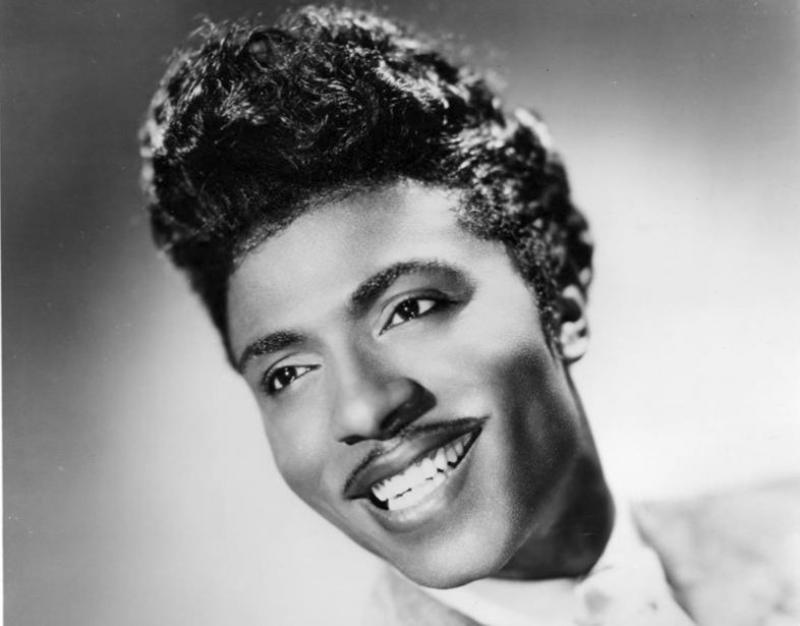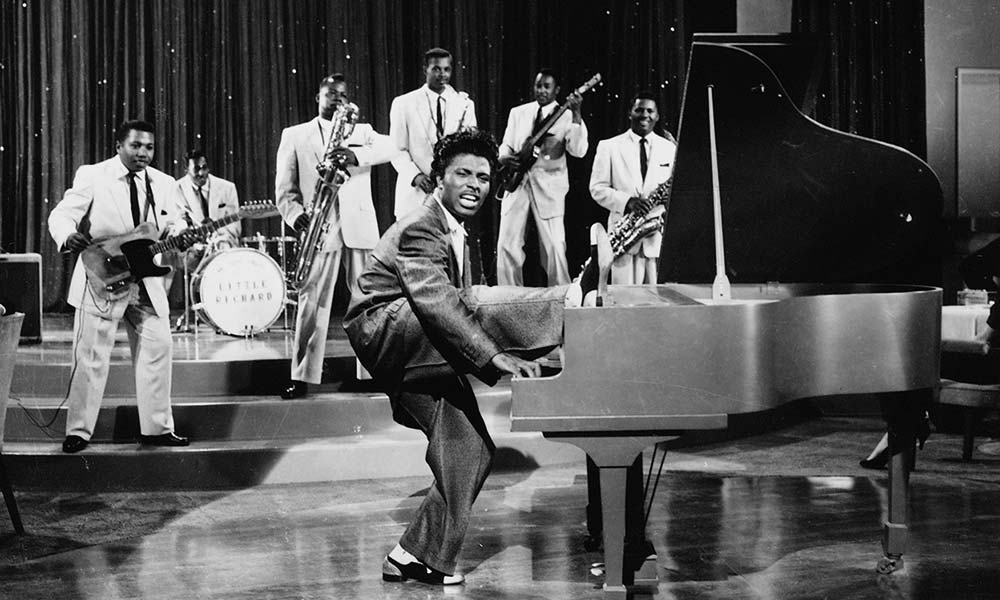Little Richard (1932-2020) - sexuality, spirituality and rock'n'roll's gospel roots | reviews, news & interviews
Little Richard (1932-2020) - sexuality, spirituality and rock'n'roll's gospel roots
Little Richard (1932-2020) - sexuality, spirituality and rock'n'roll's gospel roots
An appreciation of the late star's unique artistry

The day that Little Richard’s death was announced, my friend the soul singer PP Arnold wrote on her Instagram feed, of a “sanctified boogie-woogie piano style that was just electric”. She went on, recalling first hearing the man’s undiluted craziness: “I loved it when he did that "ooo" thing after the “Tutti Frutti aw Rudi” bit that sounded like one of the high soprano sisters in church”.
He was a brilliant purveyor of wild dance music but Richard Penniman (1932-2020) was deep down a shaman who knew how to raise hell in the sacred church of rock’n’roll, blurring the boundaries between sexuality and spirituality in a way that was more playful and crazily Dionysiac than the music of white boys such as Bill Haley, Elvis or for that matter the Beatles. Elvis had listened to gospel radio shows, especially Sister Rosetta Tharpe – who'd first discovered Little Richard in 1947. Although Presley was a great deal closer to the source than some, and managed to shock the guardians of Protestant purity with his suggestive pelvic gyrations, he stopped well short of the ecstatic shouts and screams at the heart of the possession cults that characterised the Holiness churches of the Deep South.
I grew up in an atmosphere of atheist fundamentalism: my parents, with their open marriage and existentialist credo told me that God didn’t exist, he was like Father Christmas. They were devoted to classical music, and little else was heard in our home. My first taste of the soul inherent in music of African descent hit our household when I was seven: a collection of fabulous calypso tracks – not the sanitised hits of Harry Belafonte, but joyous tracks like Roaring Lion’s still mind-blowing “J'ouvert Barrio”, driven by complex flowing polyrhythms and wailing horns. This was the music of Trinidad’s carnival, with references in the call-and-response lyrics to bacchanalian hip-shaking and a whole lot more. I could never get enough of it. Mozart was fine, but Roaring Lion awakened something, and made me want to dance. Without knowing it, I was being initiated into the cult of Dionysus – the god of madness and possession, the ‘loosener’ who makes you high, and takes you to the other side.

Bill Haley, Elvis, Jerry Lee Lewis and Eddie Cochran touched something similar. Their instant success doubtlessly tapped into an unconscious collective thirst for a spirituality that embraced the erotic, and encouraged transcendence. When Little Richard came along – with high-octane hits like “Tutti Frutti”, “Rip it Up” and "Long Tall Sally", it was as if the volcanic energies expressed in the white boys' relatively tempered songs were now being drawn from the fiery source that had inspired them. No wonder white churchmen panicked: they instinctively knew that this was a phenomenon that would draw young people away from organised Christian worship, and ultimately lead (though no-one knew it) to the collective celebrations that came much later, though were undoubtedly rooted in the liberation that came with rock’n’roll: the acid and weed-fuelled love-ins of the 1960s and the ecstasy-nourished and loved-up dance marathons of the rave explosion.
Little Richard observed in an interview that his people sang “to feel their connection with God”. One of his role models was Brother Joe May, a gospel singer and preacher with a remarkable vocal range that allowed him to express every shade of soulful experience, from the sweetness of devotion to the fury of spirit-possession. This was healing music, contagious as anything, the pulsating heart of church meetings. The congregation would move to the music, and allow it to possess them, as the spirit filled them with otherworldly energy.
Little Richard – and so many others – took this repertoire of melisma, growling and screeching to its utmost limits. In African and African-American aesthetics, according to Robert Farris Thompson, author of the revelatory Flash of the Spirit, distortion or a "dirty sound" – so present in gospel, blues and indeed jazz – are all about touching the realm of the divine. You could hear echoes of Little Richard's paradoxical and winning mixture of unbridled emotion and perfect control in James Brown, Prince and many others who knew how to blast open the door to each listener’s heart. He may have, like Al Green and Solomon Burke, made a show of renouncing the “devil’s music” and returned to the church that originally nurtured him, but beyond the hypocrisy at the heart of the black church's refusal to recognise the powerfully sexual nature of gospel music, he remained true to the spirit that moves within us, when called with a passion that cannot be denied. This was party music with a hotline to the beyond: let's keep ripping it up and feel the touch of heaven as we dance!
The future of Arts Journalism
You can stop theartsdesk.com closing!
We urgently need financing to survive. Our fundraising drive has thus far raised £49,000 but we need to reach £100,000 or we will be forced to close. Please contribute here: https://gofund.me/c3f6033d
And if you can forward this information to anyone who might assist, we’d be grateful.

Subscribe to theartsdesk.com
Thank you for continuing to read our work on theartsdesk.com. For unlimited access to every article in its entirety, including our archive of more than 15,000 pieces, we're asking for £5 per month or £40 per year. We feel it's a very good deal, and hope you do too.
To take a subscription now simply click here.
And if you're looking for that extra gift for a friend or family member, why not treat them to a theartsdesk.com gift subscription?
more New music
 Slovenian avant-folk outfit Širom’s 'In the Wind of Night, Hard-Fallen Incantations Whisper' opens the door to inner space
Unconventional folk-based music which sounds like nothing else
Slovenian avant-folk outfit Širom’s 'In the Wind of Night, Hard-Fallen Incantations Whisper' opens the door to inner space
Unconventional folk-based music which sounds like nothing else
 'The Art of Loving': Olivia Dean's vulnerable and intimate second album
Neo soul Londoner's new release outgrows her debut
'The Art of Loving': Olivia Dean's vulnerable and intimate second album
Neo soul Londoner's new release outgrows her debut
 Music Reissues Weekly: The Peanut Butter Conspiracy - The Most Up Till Now
Definitive box-set celebration of the Sixties California hippie-pop band
Music Reissues Weekly: The Peanut Butter Conspiracy - The Most Up Till Now
Definitive box-set celebration of the Sixties California hippie-pop band
 Doja Cat's 'Vie' starts well but soon tails off
While it contains a few goodies, much of the US star's latest album lacks oomph
Doja Cat's 'Vie' starts well but soon tails off
While it contains a few goodies, much of the US star's latest album lacks oomph
 Mariah Carey is still 'Here for It All' after an eight-year break
Schmaltz aplenty but also stunning musicianship from the enduring diva
Mariah Carey is still 'Here for It All' after an eight-year break
Schmaltz aplenty but also stunning musicianship from the enduring diva
 Album: Solar Eyes - Live Freaky! Die Freaky!
Psychedelic indie dance music with a twinkle in its eye
Album: Solar Eyes - Live Freaky! Die Freaky!
Psychedelic indie dance music with a twinkle in its eye
 Album: Night Tapes - portals//polarities
Estonian-voiced, London-based electro-popsters' debut album marks them as one to watch for
Album: Night Tapes - portals//polarities
Estonian-voiced, London-based electro-popsters' debut album marks them as one to watch for
 Album: Mulatu Astatke - Mulatu Plays Mulatu
An album full of life, coinciding with a 'farewell tour'
Album: Mulatu Astatke - Mulatu Plays Mulatu
An album full of life, coinciding with a 'farewell tour'
 Music Reissues Weekly: Sly and the Family Stone - The First Family: Live At Winchester Cathedral 1967
Must-have, first-ever release of the earliest document of the legendary soul outfit
Music Reissues Weekly: Sly and the Family Stone - The First Family: Live At Winchester Cathedral 1967
Must-have, first-ever release of the earliest document of the legendary soul outfit
 Album: Robert Plant - Saving Grace
Mellow delight from former Zep lead
Album: Robert Plant - Saving Grace
Mellow delight from former Zep lead
 Brìghde Chaimbeul, Round Chapel review - enchantment in East London
Inscrutable purveyor of experimental Celtic music summons creepiness and intensity
Brìghde Chaimbeul, Round Chapel review - enchantment in East London
Inscrutable purveyor of experimental Celtic music summons creepiness and intensity
 Album: NewDad - Altar
The hard-gigging trio yearns for old Ireland – and blasts music biz exploitation
Album: NewDad - Altar
The hard-gigging trio yearns for old Ireland – and blasts music biz exploitation

Add comment